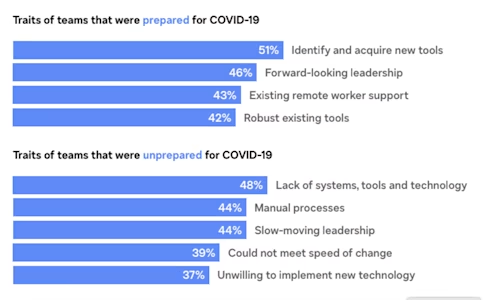
Procurement priorities: Survey shows cost control and supplier resilience matter most to buying teams
A survey of over 800 procurement professionals shares lessons learned during COVID-19 and provides clear predictions about what’s ahead for the industry.

In the past year or so, global supply chains were thrown into disarray. Supplier relationships were tested to the limits. Procurement processes transformed to suit new ways of working. Having made it through the worst of the storm, procurement teams around the world can now take stock and reflect on how they handled procurement during a crisis.
Given all they’ve been through, we reckon they have some invaluable insights to share.
Which is why we decided to conduct a survey of more than 800 procurement professionals from around the world. The results are contained in a new eBook, Global Procurement Trends and Priorities.
If, like many procurement professionals, you’re time-poor, then read on for a quick summary of the main takeouts from the eBook. Or, if you’ve got a free moment, read the full version now.
No surprise that cost savings are a top priority
Procurement teams across the globe are focused on cost savings. This is no surprise – it is, after all, one of their primary reasons for existence, right? But it gets interesting when you look beyond this obvious top priority to see what else matters most in procurement. It’s clear that supplier performance and continuity are high on the procurement agenda, too.
According to the survey, the top priorities include:
– Cost savings (47%)
– Improving supply/demand accuracy (42%)
– Decreasing manual tasks (38%)
– Improving compliance/risk management (38%)
– Improving supplier relationships (35%)
Looking internally, collaboration is a key challenge
Managing supply chain disruption is predicted to be an ongoing issue for procurement teams. They’re focused on building a network of reliable suppliers to prepare for whatever disruptions will surface next – and the first step they need to take is improving the internal partnerships that kick-start supplier relationships.
The survey found that too many internal partnerships are problematic. The survey respondents resoundingly found that collaborators on procurement contracts are challenging at least 40% of the time, with legal (57%) and marketing (52%) departments the most difficult to deal with.
The most common issues getting in the way of these relationships are:
– Poor communication (43%)
– Lack of visibility (40%)
– Burdensome manual processes (40%)
It’s all made worse by the fact that, for 67% of organisations, most or all signatures are still on paper. And, given that 66% of organisations are dealing with complex or very complex processes, all this paperwork can really start to hold them back.
Tech maturity a measure of COVID-19 success
The survey then explored how procurement teams weathered the storm of COVID-19. Those that were able to successfully navigate the pandemic were more technologically advanced than those who didn’t.

Looking ahead, the lessons are clear
Across the board, procurement teams are realising the importance of building an end-to-end
technology stack that gives them more control over both internal partnerships with other lines of business, and with the external suppliers they deal with day to day.
As teams look to expand their digital toolkit, their goals with new technologies are to save time (49% of respondents) and reduce errors (48%). They want to automate manual tasks, build resilient supplier networks and implement a robust agreement infrastructure that unlocks gains in business continuity, compliance and cost control.
As the eBook shows, it’s certainly possible to get there. The Docusign Agreement Cloud for Procurement streamlines every step in a contract’s lifecycle, including integrations and automation along the way to increase efficiency and improve the experience for procurement professionals – providing a proven path forward for controlling the costs associated with agreements, improving internal collaboration efforts and building a flexible contracting process for future success.
Related posts
Docusign IAM is the agreement platform your business needs


